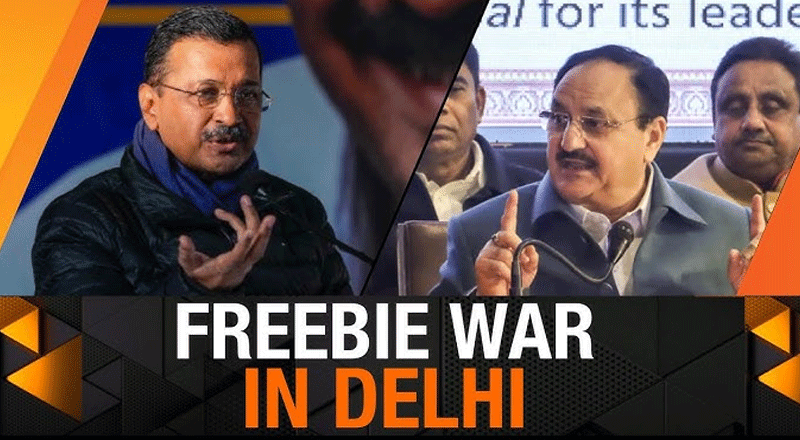The High-Stakes Battle for Delhi
As Delhi prepares to vote on February 5, the political battleground is heating up between the Bharatiya Janata Party (BJP) and the Aam Aadmi Party (AAP). After securing unexpected victories in two state elections last year, largely through a strategy of cash handouts and populist measures, Prime Minister Narendra Modi’s BJP is now attempting to reclaim Delhi after nearly three decades. However, standing in its way is AAP, which has governed the national capital for the past ten years, building its voter base through welfare schemes such as free water and electricity for the poor.
Governance of Delhi, a city of 20 million, carries immense prestige, despite its status as a national capital territory where key administrative powers, including police control, remain under the federal government. This dynamic has led to frequent clashes between the BJP-led central government and the AAP-led state government over jurisdiction and governance.
BJP’s Strategy: Outdoing AAP on Welfare Schemes
To counter AAP’s appeal among Delhi’s lower-income groups, the BJP has announced a series of ambitious welfare measures. These include:
- A monthly cash payment of ₹2,500 to all poor women.
- A one-time payment of ₹21,000 to each pregnant woman.
- Subsidized cooking gas for households.
- A ₹2,500 monthly pension for senior citizens.
- A ₹15,000 grant for youth preparing for competitive exams.
- A ₹1,000 monthly stipend for students from underprivileged backgrounds enrolled in technical and vocational courses.
BJP lawmaker Anurag Thakur stated, “Our manifesto has unsettled our opponents. They are scared that we are giving direct benefits to the people, just as they have done in the past.”
AAP’s Response: Holding Ground with Populism
The AAP, known for its pro-poor policies, has dismissed BJP’s welfare promises as an imitation of its own governance model. Its campaign is centered around:
- A ₹2,100 monthly payment to unemployed women.
- A ₹18,000 monthly salary to Hindu priests and Sikh granthis (ceremonial religious leaders).
- Financial support for students from underprivileged backgrounds pursuing foreign education.
- Free uniforms and financial assistance for autorickshaw drivers and their daughters’ weddings.
AAP remains confident of its electoral prospects, citing its track record in delivering welfare schemes. Polling agency CVoter founder Yashwant Deshmukh noted, “AAP has an edge, especially among women voters. Our survey shows that nearly half of Delhi’s voters do not wish to change the current government.”
Economic Impact: Are These Promises Sustainable?
Delhi’s government has already budgeted nearly ₹63 billion ($728 million) in the current fiscal year for subsidies, including free electricity, cash handouts, and free bus services for women. If the additional promises from either party are implemented post-election, it could mean an extra ₹50 billion in expenditure, pushing subsidy spending to nearly 20% of the total budget.
While populist schemes have become a staple of Indian elections, concerns are mounting over their long-term fiscal sustainability. The Reserve Bank of India recently warned that excessive welfare spending could divert funds away from crucial infrastructure and development projects. Additionally, high government borrowing to finance these programs could place further strain on public finances.
The Middle-Class Dilemma: AAP’s Outreach vs BJP’s Criticism
AAP leader Arvind Kejriwal has attempted to appeal to the middle class by highlighting issues such as rising taxation and inadequate government services. He argued that middle-income earners are being treated as the “government’s ATM” while receiving little in return. His seven-point demand list for the upcoming national budget includes:
- A cap on private school fees.
- Increased subsidies for higher education.
- A higher health budget.
- Tax exemptions on health insurance premiums.
- Removal of GST on essential commodities.
Retirement benefits and concessions for senior citizens.
Kejriwal criticized the BJP-led central government, stating, “Successive governments have crushed and squeezed the middle class. They pay huge taxes but receive nothing in return.”
BJP spokesperson RP Singh dismissed Kejriwal’s claims, saying, “AAP has failed to deliver on its promises. Where is the free WiFi? Where is clean water? Every household uses an RO filter because AAP failed to improve water quality.”
The Road to February 5
As Delhi heads to the polls, both BJP and AAP are banking on their respective welfare promises to sway voters. While BJP aims to unseat AAP by expanding its appeal among lower-income groups, AAP is relying on its existing welfare schemes and middle-class outreach to retain power.
Opinion polls currently indicate an advantage for AAP, but with both parties aggressively campaigning and making new promises, the final outcome remains uncertain. The results on February 8 will determine whether BJP’s strategy to outdo AAP on populist policies will pay off or whether Kejriwal’s governance model will continue to dominate the capital’s political landscape.
(With inputs from agencies)





